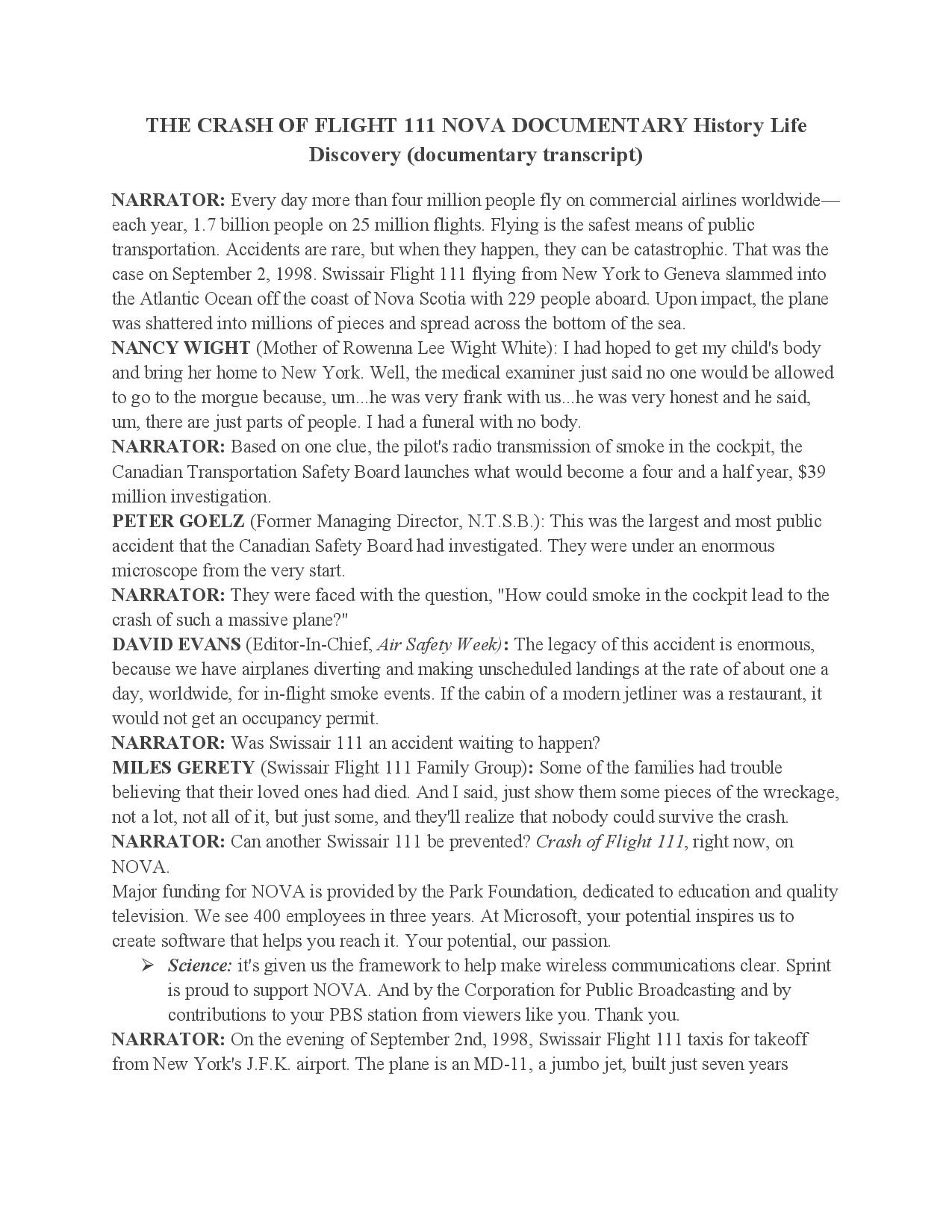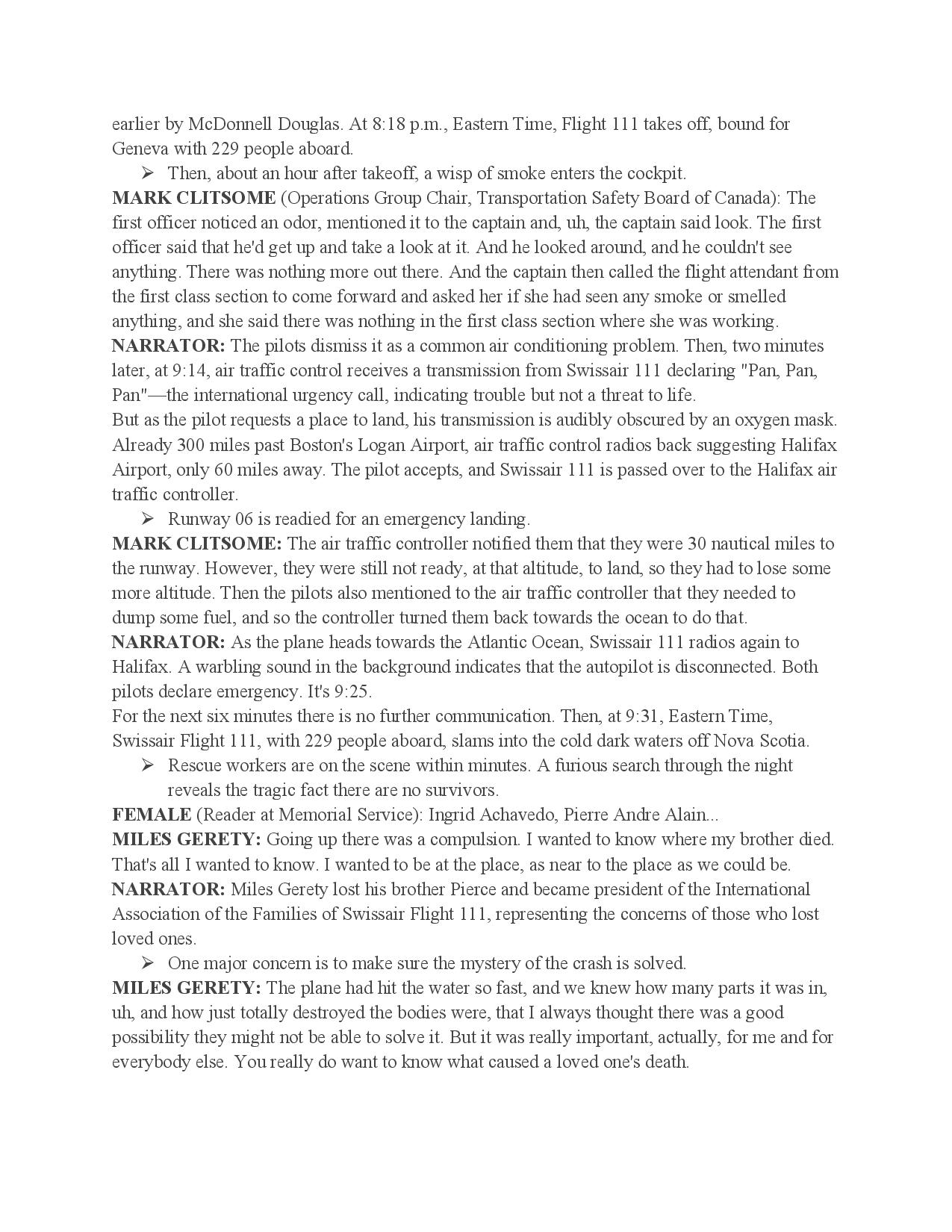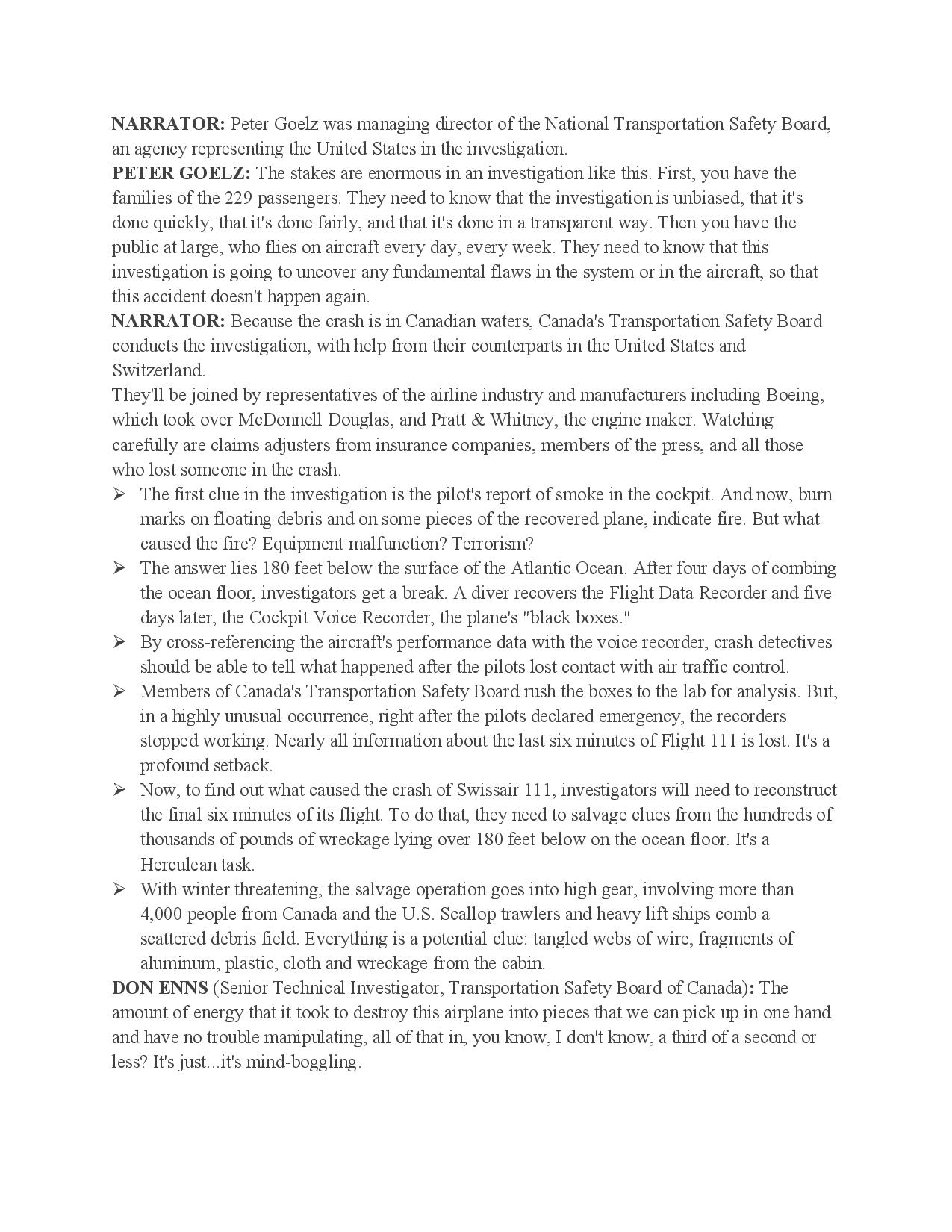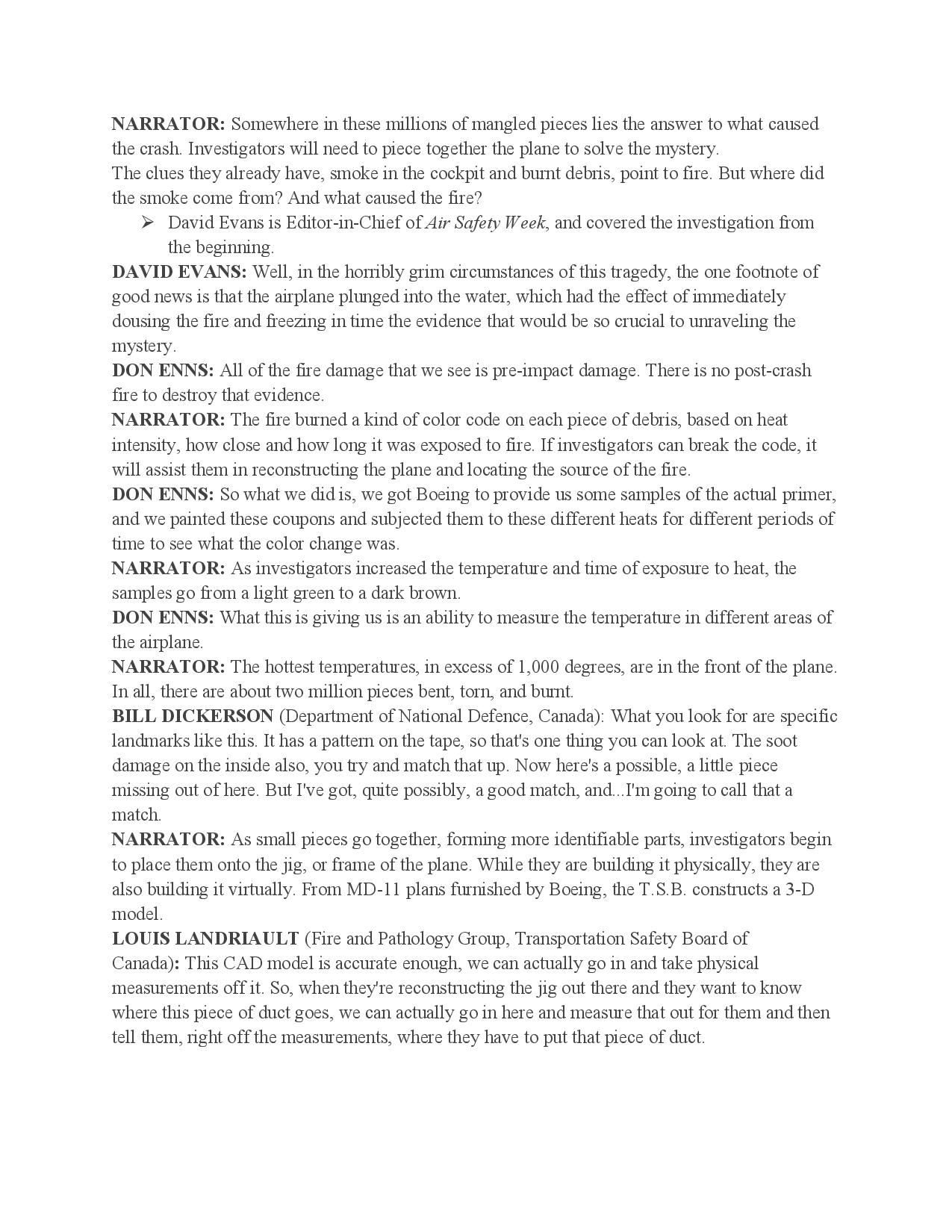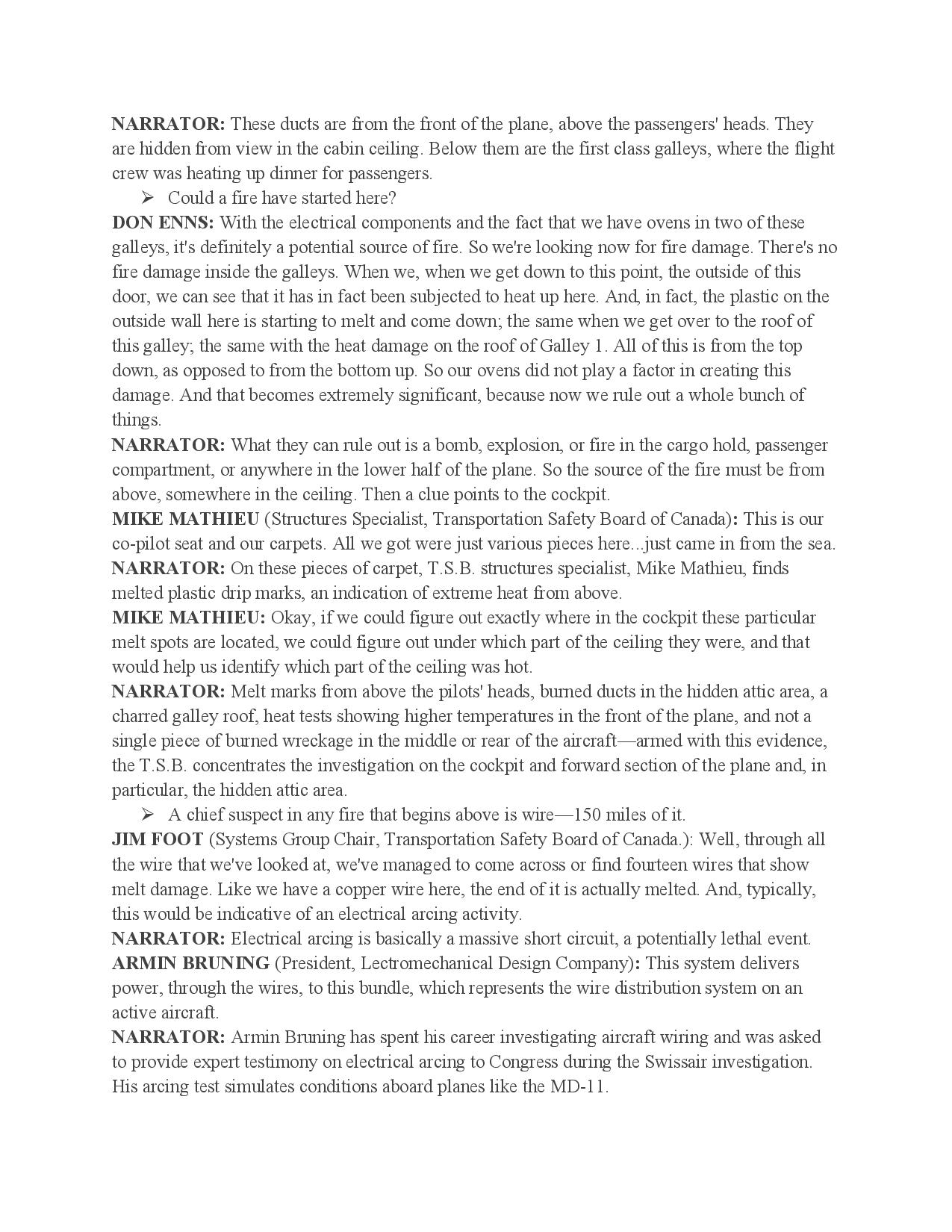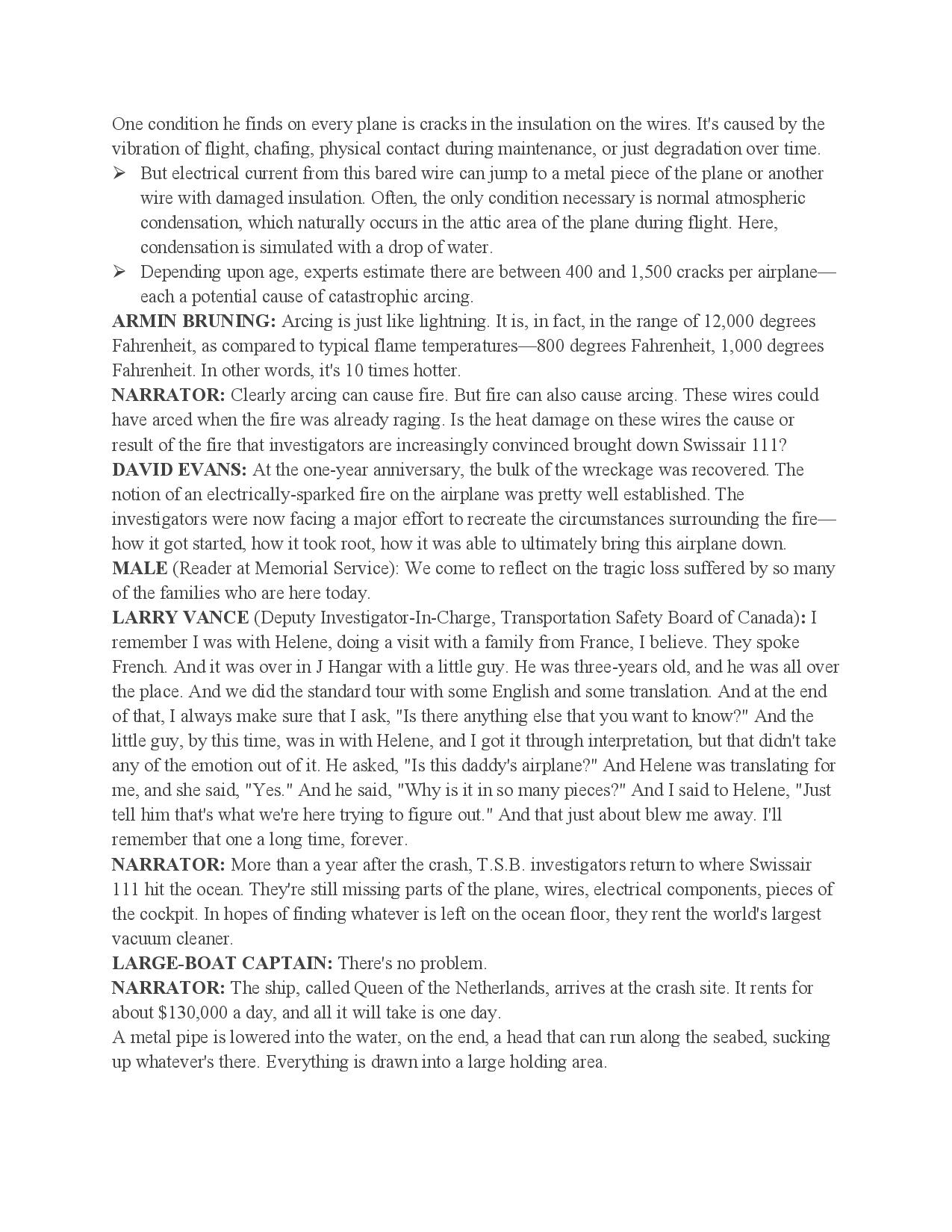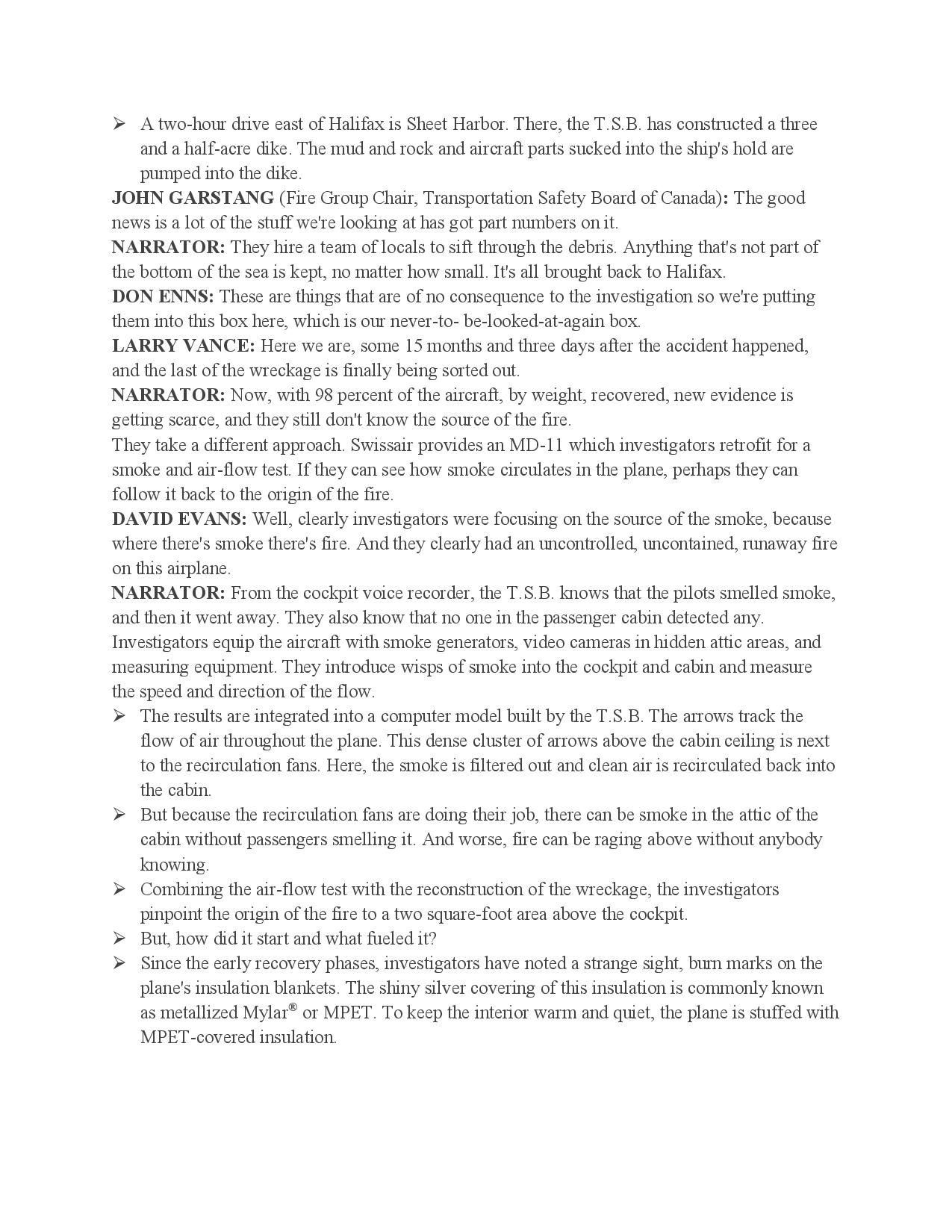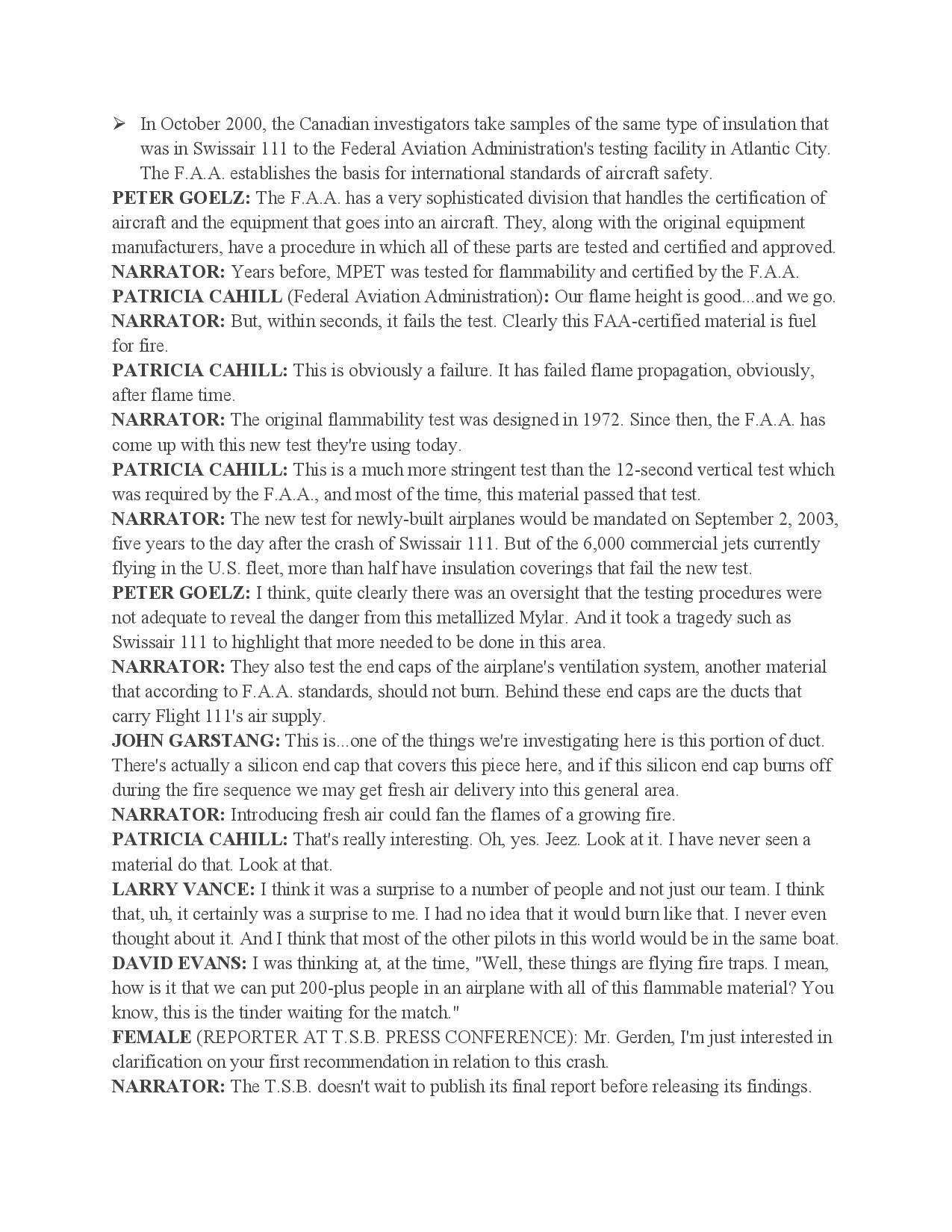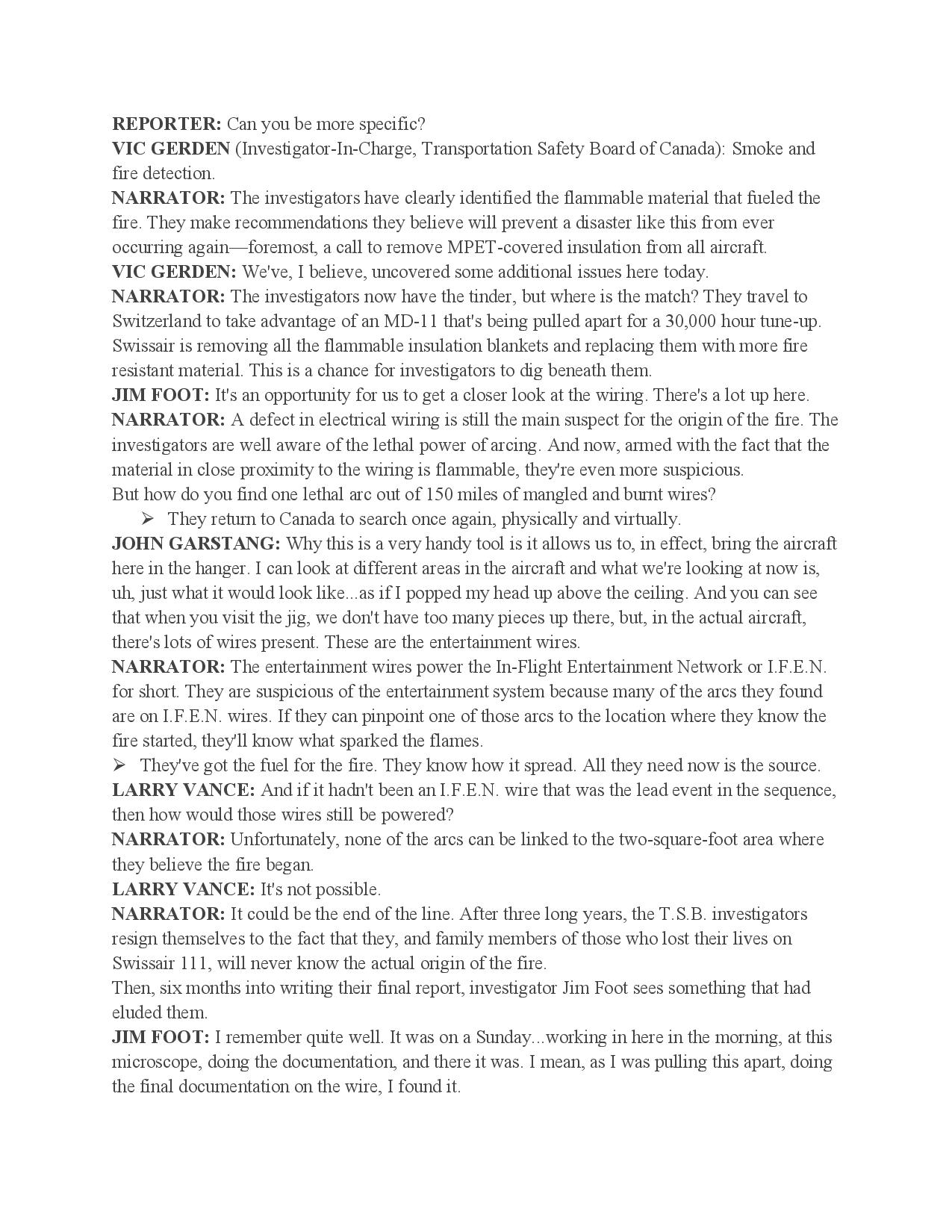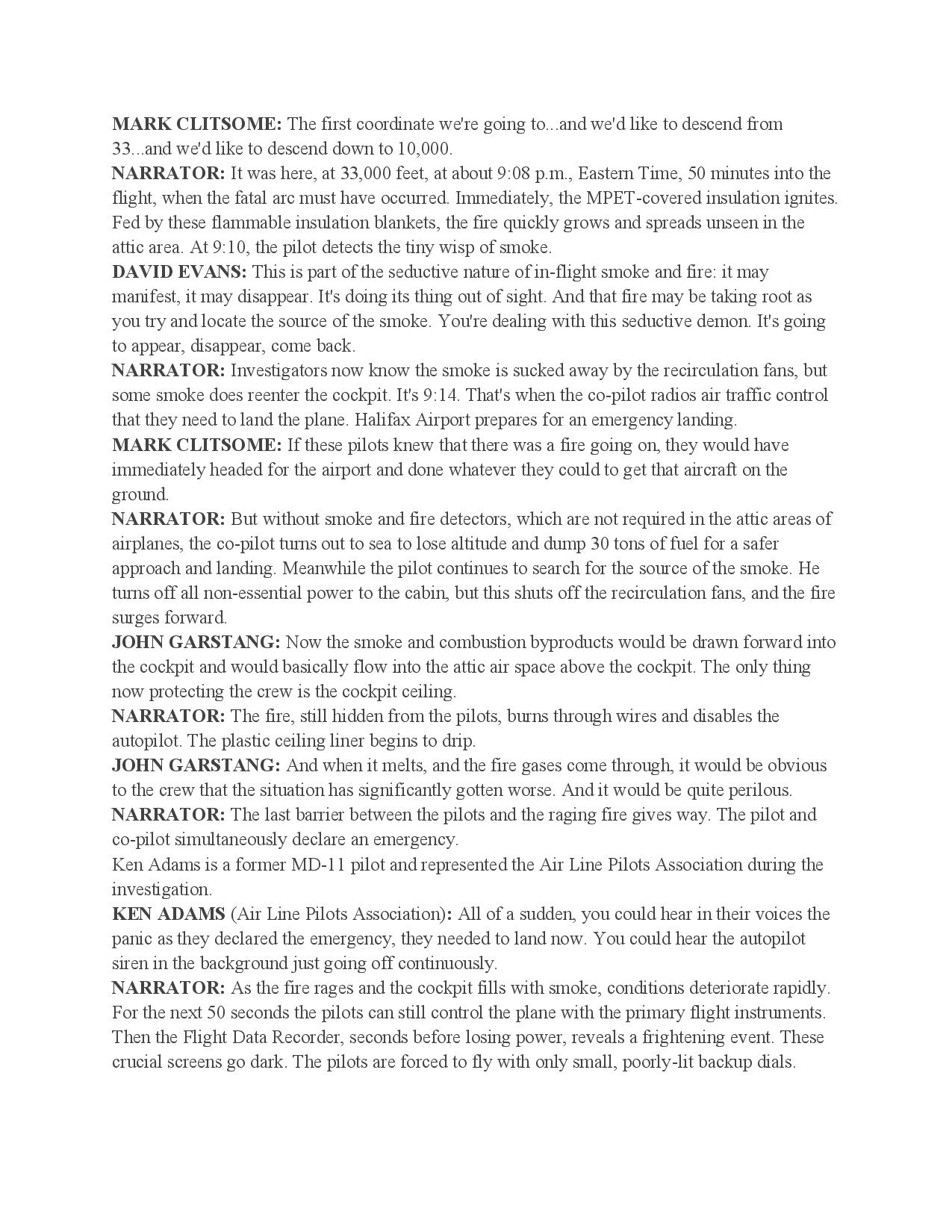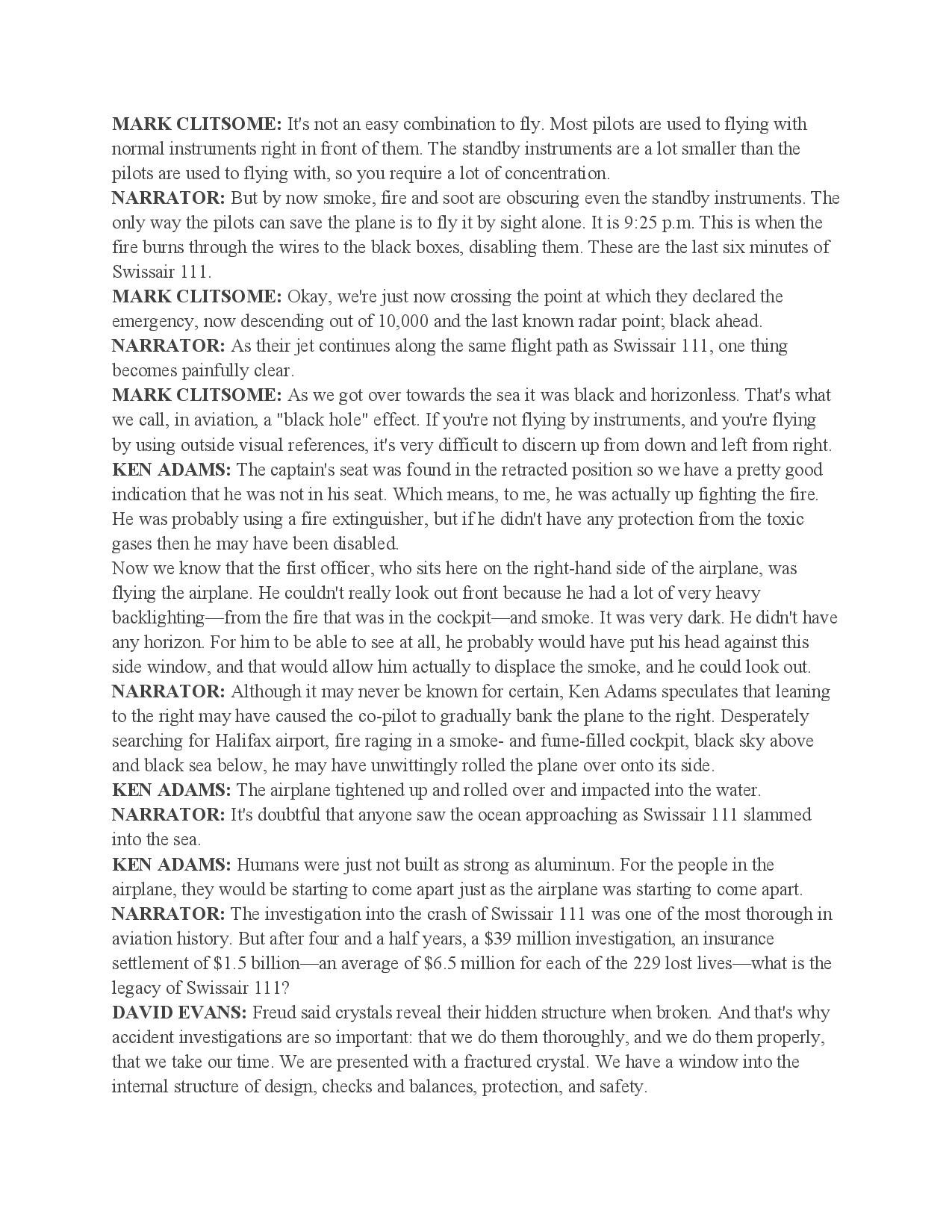Answer the following questions in detail after reviewing the video transcripts of "THE CRASH OF FLIGHT 111 NOVA DOCUMENTARY History Life Discovery" provided at the end.
- Which agencies/organizations/individuals/etc. were involved with this accident investigation? (Name at least 3)
- Which was the lead agency?
- What was the primary cause of the crash? How did the investigators discover this?
Note: The document from where the asked questions can be answered is as follows:
THE CRASH OF FLIGHT 111 NOVA DOCUMENTARY History Life Discovery (documentary transcript) NARRATOR: Every day more than four million people y on commercial airlines worldwide each year, 1.7 billion people on 25 million ights. Flying is the safest means of public transportation. Accidents are rare, but when they happen, they can be catastrophic. That was the case on September 2, 1998. Swissair Flight 1 ll ying from New York to Geneva slammed into the Atlantic Ocean off the coast of Nova Scotia with 229 people aboard. Upon impact, the plane was shattered into millions of pieces and spread across the bottom of the sea. NANCY WIGHT (Mother of Rowenna Lee Wight White): I had hoped to get my child's body and bring her home to New York. Well, the medical examiner just said no one would be allowed to go to the morgue because, um...he was very frank with us...he was very honest and he said, um, there are just parts of people. I had a funeral with no body. NARRATOR: Based on one clue, the pilot's radio transmission of smoke in the cockpit, the Canadian Transportation Safety Board launches what would become a four and a half year, $39 million investigation. PETER GOELZ (Former Managing Director, N.T.S.B.): This was the largest and most public accident that the Canadian Safety Board had investigated. They were under an enormous microscope from the very start. NARRATOR: They were faced with the question, "How could smoke in the cockpit lead to the crash of such a massive plane?" DAVID EVANS (Editor-In-Chief, Air Safety Week): The legacy of this accident is enormous, because we have airplanes diverting and making unscheduled landings at the rate of about one a day, worldwide, for in-ight smoke events. If the cabin of a modernjetliner was a restaurant, it would not get an occupancy permit. NARRATOR: Was Swissair 111 an accident waiting to happen? MILES GERETY (Swissair Flight 11 1 Family Group): Some of the families had trouble beli eving that their loved ones had died. AndI said, just show them some pieces of the wreckage, not a lot, not all of it, but just some, and they'll realize that nobody could survive the crash. NARRATOR: Can another Swissair 11 1 be prevented? Crash of Flight 111, right now, on NOVA. Major funding for NOVA is provided by the Park Foundation, dedicated to education and quality television. We see 400 employees in three years. At Microsoft, your potential inspires us to create software that helps you reach it. Your potential, our passion. > Science: it's given us the framework to help make wireless communications clear. Sprint is proud to support NOVA. And by the Corporation for Public Broadcasting and by contributions to your PBS station from viewers like you. Thank you. NARRATOR: On the evening of September 2nd, 1998, Swissair Flight 11 l taxis for takeoff from New York's J .F.K. airport. The plane is an MD-ll, a jumbo jet, built just seven years earlier by McDonnell Douglas. At 8: 18 pm, Eastern Time, Flight 111 takes off, bound for Geneva with 229 people aboard. 'P Then, about an hour after takeoff, a wisp of smoke enters the cockpit. MARK CLITSO ME (Operations Group Chair, Transportation Safety Board of Canada): The rst officer noticed an odor, mentioned it to the captain and, uh, the captain said look. The rst ofcer said that he'd get up and take a look at it. And he looked around, and he couldn't see anything. There was nothing more out there. And the captain then called the ight attendant from the rst class section to come forward and asked her if she had seen any smoke or smelled anything, and she said there was nothing in the rst class section where she was working. NARRATOR: The pilots dismiss it as a common air conditioning problem. Then, two minutes later, at 9:14, air traffic control receives a transmission from Swissair ll 1 declaring "Pan, Pan, Pan\"the international urgency call, indicating trouble but not a threat to life. But as the pilot requests a place to land, his transmission is audibly obscured by an oxygen mask. Already 300 miles past Boston's Logan Airport, air trafc control radios back suggesting Halifax Airport, only 60 miles away. The pilot accepts, and Swissair 1 11 is passed over to the Halifax air trafc controller. 'P Runway 06 is readied for an emergency landing. MARK CLITSO ME: The air trafc controller notied them that they were 30 nautical miles to the runway. However, they were still not ready, at that altitude, to land, so they had to lose some more altitude. Then the pilots also mentioned to the air trafc controller that they needed to dump some fuel, and so the controller turned them back towards the ocean to do that. NARRATOR: As the plane heads towards the Atlantic Ocean, Swissair lll radios again to Halifax. A warbling sound in the background indicates that the autopilot is disconnected. Both pilots declare emergency. It's 9:25. For the next six minutes there is no further communication. Then, at 9:31, Eastern Time, Swissair Flight 111, with 229 people aboard, slams into the cold dark waters off Nova Scotia. > Rescue workers are on the scene within minutes. A furious search through the night reveals the tragic fact there are no survivors. FEMALE (Reader at Memorial Service): Ingrid Achavedo, Pierre Andre Alain... MILES GERETY: Going up there was a compulsion. I wanted to know where my brother died. That's all I wanted to know. I wanted to be at the place, as near to the place as we could be. NARRATOR: Miles Gerety lost his brother Pierce and became president of the International Association of the Families of Swissair Flight 11 1, representing the concerns of those who lost loved ones. > One major concern is to make sure the mystery of the crash is solved. MILES GERETY: The plane had hit the water so fast, and we knew how many parts it was in, uh, and how just totally destroyed the bodies were, that I always thought there was a good possibility they might not be able to solve it. But it was really important, actually, for me and for everybody else. You really do want to know what caused a loved one's death. NARRATOR: Peter Goelz was managing director of the National Transportation Safety Board, an agency representing the United States in the investigation. PETER GO ELZ: The stakes are enormous in an investigation like this. First, you have the families of the 229 passengers. They need to know that the investigation is unbiased, that it's done quickly, that it's done fairly, and that it's done in a transparent way. Then you have the public at large, who ies on aircraft every day, every week. They need to know that this investigation is going to uncover any fundamental aws in the system or in the aircraft, so that this accident doesn't happen again. NARRATOR: Because the crash is in Canadian waters, Canada's Transportation Safety Board conducts the investigation, with help from their counterparts in the United States and Switzerland. They'll be joined by representatives of the airline industry and manufacturers including Boeing, which took over McDonnell Douglas, and Pratt & Writney, the engine maker. Watching carefully are claims adjusters from insurance companies, members of the press, and all those who lost someone in the crash. '9 The rst clue in the investigation is the pilot's report of smoke in the cockpit. And now, burn marks on oating debris and on some pieces of the recovered plane, indicate re. But what caused the re? Equipment malfunction? Terrorism? P The answer lies 180 feet below the surface of the Atlantic Ocean. After four days of combing the ocean oor, investigators get a break. A diver recovers the Flight Data Recorder and ve days later, the Cockpit Voice Recorder, the plane's \"black boxes." > By cross-referencing the aircraft's performance data with the voice recorder, crash detectives should be able to tell what happened after the pilots lost contact with air trafc control. Fe Members of Canada's Transportation Safety Board rush the boxes to the lab for analysis. But, in a highly unusual occurrence, right after the pilots declared emergency, the recorders stopped working. Nearly all information about the last six minutes of Flight 11 1 is lost. It's a profound setback. > Now, to find out what caused the crash of Swissair 11 1, investigators will need to reconstruct the nal six minutes of its ight. To do that, they need to salvage clues from the hundreds of thousands of pounds of wreckage lying over 180 feet below on the ocean oor. It's a Hercule an task. 'P With winter threatening, the salvage operation goes into high gear, involving more than 4,000 people om Canada and the US. Scallop trawlers and heavy lift ships comb a scattered debris eld. Everything is a potential clue: tangled webs of wire, fragments of aluminum, plastic, cloth and wreckage from the cabin. DON ENNS (Senior Technical Investigator, Transportation Safety Board of Canada): The amount of energy that it took to destroy this airplane into pieces that we can pick up in one hand and have no trouble manipulating, all of that in, you know, I don't know, a third of a second or less? It's just. ..it's mind-boggling. NARRATOR: Somewhere in these millions of mangled pieces lies the answer to what caused the crash. Investigators will need to piece together the plane to solve the mystery. The clues they already have, smoke in the cockpit and burnt debris, point to re. But where did the smoke come from? And what caused the re? > David Evans is Editor-inChief of Air Safeg) Week, and covered the investigation from the beginning. DAVID EVANS: Well, in the horribly grim circumstances of this tragedy, the one footnote of good news is that the airplane plunged into the water, which had the effect of immediately dousing the re and freezing in time the evidence that would be so crucial to unraveling the mystery. DON ENNS: All of the re damage that we see is pre-impact damage. There is no post-crash re to destroy that evidence. NARRATOR: The re burned a kind of color code on each piece of debris, based on heat intensity, how close and how long it was exposed to re. If investigators can break the code, it will assist them in reconstructing the plane and locating the source of the re. DON ENNS: So what we did is, we got Boeing to provide us some samples of the actual primer, and we painted these coupons and subjected them to these different heats for different periods of time to see what the color change was. NARRATOR: As investigators increased the temperature and time of exposure to heat, the samples go from a light green to a dark brown. DON ENNS: What this is giving us is an ability to measure the temperature in different areas of the airplane. NARRATOR: The hottest temperatures, in excess of 1,000 degrees, are in the front of the plane. In all, there are about two million pieces bent, torn, and burnt. BILL DICKERSON (Department of National Defence, Canada): What you look for are specic landmarks like this. It has a pattern on the tape, so that's one thing you can look at. The soot damage on the inside also, you try and match that up. Now here's a possible, a little piece missing out of here. But I've got, quite possibly, a good match, and...I'm going to call that a match. NARRATOR: As small pieces go together, forming more identiable parts, investigators begin to place them onto the jig, or frame of the plane. While they are building it physically, they are also building it virtually. From MD-ll plans furnished by Boeing, the T. SB. constructs a 3-D model. LOUIS LAN DRIAULT (Fire and Pathology Group, Transportation Safety Board of Canada): This CAD model is accurate enough, we can actually go in and take physical measurements off it. So, when they're reconstructing the jig out there and they want to know where this piece of duct goes, we can actually go in here and measure that out for them and then tell them, right off the measurements, where they have to put that piece of duct. NARRATOR: These ducts are from the front of the plane, above the passengers' heads. They are hidden from view in the cabin ceiling. Below them are the rst class galleys, where the ight crew was heating up dinner for passengers. > Could a re have started here? DON ENNS: With the electrical components and the fact that we have ovens in two of these galleys, it's denitely a potential source of re. So we're looking now for re damage. There's no re damage inside the galleys. When we, when we get down to this point, the outside of this door, we can see that it has in fact been subjected to heat up here. And, in fact, the plastic on the outside wall here is starting to melt and come down; the same when we get over to the roof of this galley; the same with the heat damage on the roof of Galley 1. All of this is from the top down, as opposed to from the bottom up. So our ovens did not play a factor in creating this damage. And that becomes extremely signicant, because now we rule out a whole bunch of things. NARRATOR: What they can rule out is a bomb, explosion, or re in the cargo hold, passenger compartment, or anywhere in the lower half of the plane. So the source of the re must be from above, somewhere in the ceiling. Then a clue points to the cockpit. MIKE MATHIEU (Structures Specialist, Transportation Safety Board of Canada): This is our co-pilot seat and our carpets. All we got were just various pieces here...just came in from the sea. NARRATOR: On these pieces of carpet, T.S.B. structures specialist, Mike Mathieu, nds melted plastic drip marks, an indication of extreme heat from above. MIKE MATHIEU: Okay, if we could gure out exactly where in the cockpit these particular melt spots are located, we could gure out under which part of the ceiling they were, and that would help us identify which part of the ceiling was hot. NARRATOR: Melt marks from above the pilots' heads, burned ducts in the hidden attic area, a charred galley roof, heat tests showng higher temperatures in the front of the plane, and not a single piece of burned wreckage in the middle or rear of the aircraftarmed with this evidence, the T.S.B. concentrates the investigation on the cockpit and forward section of the plane and, in particular, the hidden attic area. 'P A chief suspect in any re that begins above is wire150 miles ofit. JIM FOOT (Systems Group Chair, Transportation Safety Board of Canada): Well, through all the wire that we've looked at, we've managed to come across or nd fourteen wires that show melt damage. Like we have a copper wire here, the end of it is actually melted. And, typically, this would be indicative of an electrical arcing activity. NARRATOR: Electrical arcng is basically a massive short circuit, a potentially lethal event. ARMIN BRUNING (President, Lectromechanical Design Company): This system delivers power, through the wires, to this bundle, which represents the wire distribution system on an active aircraft. NARRATOR: Armin Bruning has spent his career investigating aircraft wiring and was asked to provide expert testimony on electrical arcing to Congress during the Swissair investigation. His arcing test simulates conditions aboard planes like the MD-l 1. One condition he nds on every plane is cracks in the insulation on the wires. It's caused by the vibration of ight, chang, physical contact during maintenance, or just degradation over time. 'P But electrical current om this bared wire can jump to a metal piece of the plane or another wire with damaged insulation. Often, the only condition necessary is normal atmospheric condensation, which naturally occurs in the attic area of the plane during ight. Here, condensation is simulated with a drop of water. P Depending upon age, experts estimate there are between 400 and 1,500 cracks per airplane each a potential cause of catastrophic arcing. ARMIN BRUNING: Arcing is just like lightning. It is, in fact, in the range of 12,000 degrees Fahrenheit, as compared to typical ame temperatures800 degrees Fahrenheit, 1,000 degrees Fahrenheit. In other words, it's 10 times hotter. NARRATOR: Clearly arcing can cause re. But re can also cause arcing. These wires could have arced when the re was already raging. Is the heat damage on these wires the cause or result of the re that investigators are increasingly convinced brought down Swissair lll? DAVID EVANS: At the one-year anniversary, the bulk of the wreckage was recovered. The notion of an electrically-sparked re on the airplane was pretty well established. The investigators were now facing a major effort to recreate the circumstances surrounding the re how it got started, how it took root, how it was able to ultimately bring this airplane down. MALE (Reader at Memorial Service): We come to reect on the tragic loss suffered by so many of the families who are here today. LARRY VANCE (Deputy Investigator-InCharge, Transportation Safety Board of Canada): I remember I was with Helene, doing a visit with a family from France, I believe. They spoke French. And it was over in J Hangar with a little guy. He was three-years old, and he was all over the place. And we did the standard tour with some English and some translation. And at the end of that, I always make sure that I ask, "Is there anything else that you want to know?" And the little guy, by this time, was in with Helene, and I got it through interpretation, but that didn't take any of the emotion out of it. He asked, "Is this daddy's airplane?" And Helene was translating for me, and she said, \"Yes. " And he said, "Why is it in so many pieces?" And I said to Helene, "Just tell him that's what we're here trying to gure out. " And that just about blew me away. I'll remember that one a long time, forever. NARRATOR: More than a year after the crash, T.S.B. investigators return to where Swissair lll hit the ocean. TheYre still missing parts of the plane, wires, electrical components, pieces of the cockpit. In hopes of nding whatever is left on the ocean oor, they rent the world's largest vacuum cleaner. LARGE-BOAT CAPTAIN: There's no problem. NARRATOR: The ship, called Queen of the Netherlands, arrives at the crash site. It rents for about $130,000 a day, and all it will take is one day. A metal pipe is lowered into the water, on the end, a head that can run along the seabed, sucking up whatever's there. Everything is drawn into a large holding area. > A two-hour drive east of Halifax is Sheet Harbor. There, the T.S.B. has constructed a three and a half-acre dike. The mud and rock and aircraft parts sucked into the ship's hold are pumped into the dike. JOHN GARSTANG (Fire Group Chair, Transportation Safety Board of Canada): The good news is a lot of the stuff we're looking at has got part numbers on it. NARRATOR: They hire a team of locals to si through the debris. Anything that's not part of the bottom of the sea is kept, no matter how small. It's all brought back to Halifax. DON ENNS: These are things that are of no consequence to the investigation so we're putting them into this box here, which is our never-to- be-looked-atagain box. LARRY VANCE: Here we are, some 15 months and three days aer the accident happened, and the last of the wreckage is nally being sorted out. NARRATOR: Now, with 98 percent of the aircraft, by weight, recovered, new evidence is getting scarce, and they still don't know the source of the re. They take a different approach. Swissair provides an MD-ll which investigators retrot for a smoke and air-ow test. If they can see how smoke circulates in the plane, perhaps they can follow it back to the origin of the re. DAVID EVANS: Well, clearly investigators were focusing on the source of the smoke, because where there's smoke there's re. And they clearly had an uncontrolled, uncontained, runaway re on this airplane. NARRATOR: From the cockpit voice recorder, the T. SB. knows that the pilots smelled smoke, and then it went away. They also know that no one in the passenger cabin detected any. Investigators equip the aircraft with smoke generators, video cameras in hidden attic areas, and measuring equipment. They introduce wisps of smoke into the cockpit and cabin and measure the speed and direction of the ow. > The results are integrated into a computer model built by the T.S.B. The arrows track the ow of air throughout the plane. This dense cluster of arrows above the cabin ceiling is next to the recirculation fans. Here, the smoke is ltered out and clean air is recirculated back into the cabin. iv\" But because the recirculation fans are doing their job, there can be smoke in the attic of the cabin without passengers smelling it. And worse, re can be raging above without anybody knowing. 'P Combining the air-ow test with the reconstruction of the wreckage, the investigators pinpoint the origin of the re to a two square-foot area above the cockpit. P But, how did it start and what fueled it? > Since the early recovery phases, investigators have noted a strange sight, burn marks on the plane's insulation blankets. The shiny silver covering of this insulation is commonly known as metallized Mylar or MPET. To keep the interior warm and quiet, the plane is stuffed with MPET-covered insulation. In October 2000, the Canadian investigators take samples of the same type of insulation that was in Swissair 1 11 to the Federal Aviation Administration's testing facility in Atlantic City. The F. A. A. establishes the basis for international standards of aircraft safety. PETER GOELZ: The F.A.A. has a very sophisticated division that handles the certification of aircraft and the equipment that goes into an aircraft. They, along with the original equipment manufacturers, have a procedure in which all of these parts are tested and certified and approved. NARRATOR: Years before, MPET was tested for flammability and certified by the F.A.A. PATRICIA CAHILL (Federal Aviation Administration): Our flame height is good.. and we go. NARRATOR: But, within seconds, it fails the test. Clearly this FAA-certified material is fuel for fire. PATRICIA CAHILL: This is obviously a failure. It has failed flame propagation, obviously, after flame time. NARRATOR: The original flammability test was designed in 1972. Since then, the F.A. A. has come up with this new test they're using today. PATRICIA CAHILL: This is a much more stringent test than the 12-second vertical test which was required by the F.A.A., and most of the time, this material passed that test. NARRATOR: The new test for newly-built airplanes would be mandated on September 2, 2003, five years to the day after the crash of Swissair 1 1 1. But of the 6,000 commercial jets currently flying in the U.S. fleet, more than half have insulation coverings that fail the new test. PETER GOELZ: I think, quite clearly there was an oversight that the testing procedures were not adequate to reveal the danger from this metallized Mylar. And it took a tragedy such as Swissair 11 1 to highlight that more needed to be done in this area. NARRATOR: They also test the end caps of the airplane's ventilation system, another material that according to F.A. A. standards, should not burn. Behind these end caps are the ducts that carry Flight 11 1's air supply. JOHN GARSTANG: This is... one of the things we're investigating here is this portion of duct. There's actually a silicon end cap that covers this piece here, and if this silicon end cap burns off during the fire sequence we may get fresh air delivery into this general area. NARRATOR: Introducing fresh air could fan the flames of a growing fire. PATRICIA CAHILL: That's really interesting. Oh, yes. Jeez. Look at it. I have never seen a material do that. Look at that. LARRY VANCE: I think it was a surprise to a number of people and not just our team. I think that, uh, it certainly was a surprise to me. I had no idea that it would burn like that. I never even thought about it. And I think that most of the other pilots in this world would be in the same boat. DAVID EVANS: I was thinking at, at the time, "Well, these things are flying fire traps. I mean, how is it that we can put 200-plus people in an airplane with all of this flammable material? You know, this is the tinder waiting for the match." FEMALE (REPORTER AT T. S.B. PRESS CONFERENCE): Mr. Gerden, I'm just interested in clarification on your first recommendation in relation to this crash. NARRATOR: The T.S.B. doesn't wait to publish its final report before releasing its findings.REPORTER: Can you be more specic? VIC GERDEN (Investigator-InCharge, Transportation Safety Board of Canada): Smoke and frre detection. NARRATOR: The investigators have clearly identied the ammable material that fueled the re. They make recommendations they believe will prevent a disaster like this from ever occurring againiforemost, a call to remove MPET-covered insulation from all aircraft. VIC GERDEN: We've, I believe, uncovered some additional issues here today. NARRATOR: The investigators now have the tinder, but where is the match? They travel to Switzerland to take advantage of an MD-11 that's being pulled apart for a 30,000 hour tune-up. Swissair is removing all the ammable insulation blankets and replacing them with more re resistant material. This is a chance for investigators to dig beneath them. JIM FOOT: It's an opportunity for us to get a closer look at the wiring. There's a lot up here. NARRATOR: A defect in electrical wiring is still the main suspect for the origin of the re. The investigators are well aware of the lethal power of arcing. And now, armed with the fact that the material in close proximity to the wiring is ammable, they're even more suspicious. But how do you nd one lethal are out of 150 miles of mangled and burnt wires? 'P They retum to Canada to search once again, physically and virtually. JOHN GARSTAN G: Why this is a very handy tool is it allows us to, in effect, bring the aircraft here in the hanger. I can look at different areas in the aircraft and what we're looking at now is, uh, just what it would look like...as if I popped my head up above the ceiling. And you can see that when you visit the jig, we don't have too many pieces up there, but, in the actual aircraft, there's lots of wires present. These are the entertainment wires. NARRATOR: The entertainment wires power the InFlight Entertainment Network or I.F.E.N. for short. They are suspicious of the entertainment system because many of the arcs they found are on I.F.E.N. wires. If they can pinpoint one of those arcs to the location where they know the re started, they'll know what sparked the ames. > They've got the fuel for the re. They know how it spread. All they need now is the source. LARRY VANCE: And if it hadn't been an I.F.E.N. wire that was the lead event in the sequence, then how would those wires still be powered? NARRATOR: Unfortunately, none of the arcs can be linked to the two-square-foot area where they believe the re began. LARRY VANCE: It's not possible. NARRATOR: It could be the end of the line. After three long years, the T.S.B. investigators resign themselves to the fact that they, and family members of those who lost their lives on Swissair 111, will never know the actual origin of the re. Then, six months into writing their nal report, investigator Jim Foot sees something that had eluded them. JIM FOOT: I remember quite well. It was on a Sunday. ..working in here in the morning, at this microscope, doing the documentation, and there it was. I mean, as I was pulling this apart, doing the nal documentation on the wire, I found it. NARRATOR: What he found was an arc on an I.F.E.N. wire that had not been seen before. Could this newly found arc be the ignition point of the re? They go back to the hangar with a list of all the brackets theyNe recovered. Brackets hold wires and they are hoping to nd the one bracket that held the arced wire. JOHN GARSTANG: We're searching, right now, to see if we can nd one that may have a potential mark on it associated with our initiating event. NARRATOR: The initiating event, or arc, probably left some damage on the metal bracket, something resembling a nick or notch carved out by a powerful surge of electricity. JOHN GARSTANG: We don't know if it's there or not. That's why we're going back through the brackets again. MALE (TSB Investigator): Looking in the interior, non-identied, there's a lot of those. JOHN GARSTANG: Okay, we have 93-92, 93-97. DON ENNS: This is one of those never-to-be-gone-throughagain-boxes, so we're going through it again. JOHN GARSTAN G: There it is: nine-three-nine-seven, right there. DON ENNS: Yeah, right back. ..why didn't we pick it up? DON ENNS: Is there still one more in here? JOHN GARSTANG: Yeah, 93-92; one to go. DON ENNS: Hey, what's the number you're looking for? JOHN GARSTANG: Ninety-three, ninety-two. That's it. It was on the floor? NARRATOR: They find every bracket on their list. JOHN GARSTANG: We're complete. NARRATOR: But none of them show damage from arcing. They do have one other possibility for tracing the arced wire to a specic location in the plane. They go back to all the wires in the suspect area and line them up according to the pattern of re damage. JOHN GARSTAN G: In theory, if this is right, we should have a hot spot near 401 and the same thing on 410. NARRATOR: Now, they hope to see whether the I.F.E.N. wire with the newly found arc ts the pattern. JOHN GARSTAN G: Well look at that. This, this is hot. There it is. It's right there. So, that matches. NARRATOR: After three and a half years, 280,000 pounds of wreckage, 150 miles of wire, theyfve tracked the origin of the re down to within a few inches and a specic split-second 12,000 degree electrical ash. Armed with every piece of the puzzle, the disaster detectives still need to answer one remaining question, "How did the re cause the crash?\" The answer is hidden in the six minutes that were missing from the black boxes. Piloting a Transport Canada jet, the T. SB. investigators decide to retrace the nal minutes of Swissair lll's last ight. MARK CLITSO ME: The rst coordinate we're going to.. .and we'd like to descend from 33. ..and we'd like to descend down to 10,000. NARRATOR: It was here, at 33,000 feet, at about 9:08 pm, Eastern Time, 50 minutes into the ight, when the fatal arc must have occurred. Immediately, the MPET-covered insulation ignites. Fed by these ammable insulation blankets, the re quickly grows and spreads unseen in the attic area. At 9:10, the pilot detects the tiny wisp of smoke. DAVID EVANS: This is part of the seductive nature of in-ight smoke and re: it may manifest, it may disappear. It's doing its thing out of sight. And that re may be taking root as you try and locate the source of the smoke. You're dealing with this seductive demon. It's going to appear, disappear, come back. NARRATOR: Investigators now know the smoke is sucked away by the recirculation fans, but some smoke does reenter the cockpit. It's 9:14. That's when the co-pilot radios air trafc control that they need to land the plane. Halifax Airport prepares for an emergency landing. MARK CLITSO ME: If these pilots knew that there was a re going on, they would have immediately headed for the airport and done whatever they could to get that aircraft on the ground. NARRATOR: But without smoke and re detectors, which are not required in the attic areas of airplanes, the co-pilot turns out to sea to lose altitude and dump 30 tons of fuel for a safer approach and landing. Meanwhile the pilot continues to search for the source of the smoke. He turns off all non-essential power to the cabin, but this shuts off the recirculation fans, and the re surges forward. JOHN GARSTANG: Now the smoke and combustion byproducts would be drawn forward into the cockpit and would basically ow into the attic air space above the cockpit. The only thing now protecting the crew is the cockpit ceiling. NARRATOR: The re, still hidden from the pilots, burns through wires and disables the autopilot. The plastic ceiling liner begins to drip. JOHN GARSTAN G: And when it melts, and the re gases come through, it would be obvious to the crew that the situation has signicantly gotten worse. And it would be quite perilous. NARRATOR: The last barrier between the pilots and the raging re gives way. The pilot and co-pilot simultaneously declare an emergency. Ken Adams is a former MD-ll pilot and represented the Air Line Pilots Association during the investigation. KEN ADAMS (Air Line Pilots Association): All of a sudden, you could hear in their voices the panic as they declared the emergency, they needed to land now. You could hear the autopilot siren in the background just going off continuously. NARRATOR: As the re rages and the cockpit lls with smoke, conditions deteriorate rapidly. For the next 50 seconds the pilots can still control the plane with the primary ight instruments. Then the Flight Data Recorder, seconds before losing power, reveals a frightening event. These crucial screens go dark. The pilots are forced to y with only small, poorly-lit backup dials. MARK CLITSO ME: It's not an easy combination to y. Most pilots are used to ying with normal instruments right in front of them. The standby instruments are a lot smaller than the pilots are used to ying with, so you require a lot of concentration. NARRATOR: But by now smoke, re and soot are obscuring even the standby instruments. The only way the pilots can save the plane is to y it by sight alone. It is 9:25 pm. This is when the re burns through the wires to the black boxes, disabling them. These are the last six minutes of Swissair 111. MARK CLITSO ME: Okay, we're just now crossing the point at which they declared the emergency, now descending out of 10,000 and the last known radar point; black ahead. NARRATOR: As their jet continues along the same ight path as Swissair 111, one thing becomes painfully clear. MARK CLITSO ME: As we got over towards the sea it was black and horizonless. That's what we call, in aviation, a \"black hole'I effect. If you're not ying by instruments, and you're ying by using outside visual references, it's very difficult to discern up from down and left from right. KEN ADAMS: The captain's seat was found in the retracted position so we have a pretty good indication that he was not in his seat. Which means, to me, he was actually up ghting the re. He was probably using a re extinguisher, but if he didn't have any protection from the toxic gases then he may have been disabled. Now we know that the rst ofcer, who sits here on the right-hand side of the airplane, was ying the airplane. He couldn't really look out front because he had a lot of very heavy backlightingifrom the re that was in the cockpitiand smoke. It was very dark. He didn't have any horizon. For him to be able to see at all, he probably would have put his head against this side window, and that would allow him actually to displace the smoke, and he could look out. NARRATOR: Although it may never be known for certain, Ken Adams speculates that leaning to the right may have caused the co-pilot to gradually bank the plane to the right. Desperately searching for Halifax airport, re raging in a smoke- and fume-lled cockpit, black sky above and black sea below, he may have unwittingly rolled the plane over onto its side. KEN ADAMS: The airplane tightened up and rolled over and impacted into the water. NARRATOR: It's doubtful that anyone saw the ocean approaching as Swissair 1 ll slammed into the sea. KEN ADAMS: Humans were just not built as strong as aluminum. For the people in the airplane, they would be starting to come apart just as the airplane was starting to come apart. NARRATOR: The investigation into the crash of Swissair 1 11 was one of the most thorough in aviation history. But after four and a half years, a $39 million investigation, an insurance settlement of $1.5 billionian average of $6.5 million for each of the 229 lost livesiwhat is the legacy of Swissair 111? DAVID EVANS: Freud said crystals reveal their hidden structure when broken. And that's why accident investigations are so important: that we do them thoroughly, and we do them properly, that we take our time. We are presented with a fractured crystal. We have a window into the internal structure of design, checks and balances, protection, and safety. NARRATOR: The Canadian Transportation Safety Board made 23 recommendations. These include: installing smoke detectors and video cameras to reveal hidden fires before they spread; streamlining the pilots' smoke checklist and implementing a fire-fighting plan for pilots and crew; increasing the size and visibility of standby instruments; providing black boxes with backup power supplies and increasing the recording time of the Cockpit Voice Recorder; inspecting aircraft wiring and setting a higher standard to prevent arcing; and, perhaps most important, new flammability standards and the removal of MPET covered insulation and all flammable materials throughout the aircraft. But safety investigators make recommendations; only civil aviation authorities, like the F.A.A., can turn them into regulations. Few of the Canadian T.S.B.'s recommendations have been fully implemented. For example, the F.A. A. gave the airlines four years to remove flammable MPET insulation. And then, at the airlines' request, extended the deadline by a year, until June 2005. DAVID EVANS: Now what do we have in the airline industry? We have what I would call a confederacy of complacency. The problem is that the hazard continues to this day. NARRATOR: MPET, the material that fueled Flight 1 1 1's deadly fire, remains in many Mcdonnell Douglas airplanes. But the problem goes beyond MPET. Other brands of flammable insulation coverings are in thousands of other planes, the majority of the U.S. commercial fleet: AN-26 Mylar in Boeing jets, foam insulation in Airbus, to name a few. The F.A. A. has not set a deadline for their removal. Another disturbing fact: the airline industry and the F.A. A. knew MPET was flammable years before Swissair 1 11. In 1993, an MD-87 jet was engulfed in flames while taxiing on a runway in Denmark. Then, in 1995, an MD-1 1 in China caught fire. Both fires were fueled by the same type of insulation blankets that were on Swissair 1 1 1. DAVID EVANS: There had been a number of accidents involving burned insulation blankets on U.S.-built aircraft flown in China. And the Chinese authorities had contacted our Federal Aviation Administration and advised them that, "Guys, you may have a flammability problem here." Action taken? None. NARRATOR: In both these major airplane fires, everyone escaped with their lives, a case study in what some call the industry's "tombstone mentality": the tendency to ignore a safety problem until lives are lost. But now lives have been lost-the lives of 229 people aboard Swissair 111- and still the T. S. B.'s call for an integrated fire-fighting philosophy is being ignored. MILES GERETY: What the Canadians figured out is, hey, wires can be a problem. You ought to make the environment around them so it is at least fire resistant. And you ought to have things like the smoke detector that I have in this house, to let people know, hey, there's a fire going on inside the walls of that plane. KEN ADAMS: We're presently having new airplanes designed, they're on the drawing board. Boeing has one. Airbus has what they call the Airbus 380, which is going to be a 550-passenger airplane. The regulations haven't changed. They do not have to provide any more fire detection or fire protection than we had on Swissair 1 1 1.DAVID EVANS: What strikes me is that so many of these accidents, about which I have written over the years, had precursor events that, had action been taken, they could have been prevented. I haven't seen one yet where structure and systems were involved, where it wasn't avoidable and preventable beforehand. And therein lies the tragedy. Therein lies the culpability. FEMALE (Reader at Memorial Service): As we come to dedicate this memorial, we give thanks for the lives of those from Flight 111, who died off these shores. FEMALE (Reader at Memorial Service): Jonathan Wilson, Brigitte Wyprontigar, Marino Xenios, Urs Zimmermann, Floris Zuber, Lee Zu. .. NARRATOR: One positive outcome of crash investigations is improvements that make ying safer. What major changes have airlines made as a result of accidents like this one? Find it on NOVA's Web site
